Assessing Spatial Variation of PBL Height and Aerosol Layer Aloft in São Paulo Megacity Using Simultaneously Two Lidar during Winter 2019
Abstract
:1. Introduction
2. Materials and Methods
2.1. São Paulo Megacity
2.2. Instrumentation
2.2.1. Metropolitan São Paulo Lidar 1 (MSP1) System
2.2.2. Metropolitan São Paulo Lidar (MSP) 2 System
2.2.3. Suomi National Polar-Orbiting Partnership (Suomi NPP) Data
2.2.4. AERONET Sunphotometer
3. Methodology
3.1. PBLH Detection
3.2. PBLH Levelness
3.3. Detection Algorithm of BB Events
4. Results
4.1. PBLH Horizontal Variation
4.1.1. Case 1: Absence of Low Clouds
4.1.2. Case 2: Presence of Low Clouds
4.1.3. All Campaign
4.2. Biomass Burning Detection
5. Conclusions
Author Contributions
Funding
Acknowledgments
Conflicts of Interest
References
- Lange, D.; Tiana-alsina, J.; Saeed, U.; Tomás, S.; Rocadenbosch, F. Using a Kalman Filter and Backscatter Lidar Returns. IEEE Trans. Geosci. Remote. Sens. 2014, 52, 4717–4728. [Google Scholar] [CrossRef]
- Bravo-Aranda, J.A.; de Arruda Moreira, G.; Navas-Guzmán, F.; Granados-Muñoz, M.J.; Guerrero-Rascado, J.L.; Pozo-Vázquez, D.; Arbizu-Barrena, C.; Olmo-Reyes, F.J.; Mallet, M.; Alados-Arboledas, L. A new methodology for PBL height estimations based on lidar depolarization measurements: Analysis and comparison against MWR and WRF model-based results. Atmos. Chem. Phys. 2017, 17, 6839–6851. [Google Scholar] [CrossRef] [Green Version]
- Moreira, G.A.; Guerrero-Rascado, J.L.; Benavent-Oltra, J.A.; Ortiz-Amezcua, P.; Román, R.; Bedoya-Velásquez, A.E.; Bravo-Aranda, J.A.; Olmo Reyes, F.J.; Landulfo, E.; Alados-Arboledas, L. Analyzing the turbulent planetary boundary layer by remote sensing systems: The Doppler wind lidar, aerosol elastic lidar and microwave radiometer. Atmos. Chem. Phys. 2019, 19, 1263–1280. [Google Scholar] [CrossRef] [Green Version]
- Liu, B.; Ma, Y.; Gong, W.; Zhang, M.; Yang, J. Improved two-wavelength Lidar algorithm for retrieving atmospheric boundary layer height. J. Quant. Spectrosc. Radiat. Transf. 2019, 224, 55–61. [Google Scholar] [CrossRef]
- Lopes, F.J.S.; Moreira, G.A.; Rodrigues, P.F.; Guerrero-Rascado, J.L.; Andrade, M.F.; Landulfo, E. Lidar measurements of tropospheric aerosol and water vapor profiles during the winter season campaigns over the metropolitan area of Sao Paulo, Brazil. In Proceedings of the Lidar Technologies, Techniques, and Measurements for Atmospheric Remote Sensing X. International Society for Optics and Photonics, San Diego, CA, USA, 20 October 2014; p. 92460H. [Google Scholar] [CrossRef]
- Ma, X.; Wang, C.; Han, G.; Ma, Y.; Li, S.; Gong, W.; Chen, J. Regional Atmospheric Aerosol Pollution Detection Based on LiDAR Remote Sensing. Rem. Sens. 2019, 11, 2339. [Google Scholar] [CrossRef] [Green Version]
- Moreira, G.A.; da Silva Lopes, F.J.; Guerrero-Rascado, J.L.; da Silva, J.J.; Arleques Gomes, A.; Landulfo, E.; Alados-Arboledas, L. Analyzing the atmospheric boundary layer using high-order moments obtained from multiwavelength lidar data: Impact of wavelength choice. Atmos. Meas. Tech. 2019, 12, 4261–4276. [Google Scholar] [CrossRef] [Green Version]
- Hu, Y.; Lu, X.; Zhai, P.; Hostetler, C.A.; Hair, J.W.; Cairns, B.; Sun, W.; Stamnes, S.; Omar, A.; Baize, R.; et al. Liquid phase cloud microphysical property estimates from CALIPSO measurements. Front. Remote. Sens. 2021, 2, 724615. [Google Scholar] [CrossRef]
- Moreira, G.A.; Guerrero-Rascado, J.L.; Bravo-Aranda, J.A.; Foyo-Moreno, I.; Cazorla, A.; Alados, I.; Lyamani, H.; Landulfo, E.; Alados-Arboledas, L. Study of the planetary boundary layer height in an urban environment using a combination of microwave radiometer and ceilometer. Atmos. Res. 2020, 240, 104932. [Google Scholar] [CrossRef]
- Mariano, G.L.; Lopes, F.J.S.; Jorge, M.P.O.M.; Landulfo, E. Assessment of biomass burnings activity with synergy of sunphotometric and LIDAR measurements in São Paulo, Brazil. Atmos. Res. 2010, 98, 486–499. [Google Scholar] [CrossRef]
- Lopez, D.H.; Rabbani, M.R.; Crosbie, E.; Raman, A.; Arellano, A.F.; Sorooshian, A. Frequency and Character of Extreme Aerosol Events in the Southwestern United States: A Case Study Analysis in Arizona. Atmosphere 2016, 7, 1. [Google Scholar] [CrossRef] [Green Version]
- Chan, K.L. Biomass burning source and their contributions to the local air quality in Hong Kong. Scien. Tot. Environ. 2017, 596, 212–221. [Google Scholar] [CrossRef]
- Kovalev, A.V.; Eichinger, E.W. Elastic Lidar: Theory, Practice and Analysis Methods; Willey Interscience: Hoboken, NJ, USA, 2004. [Google Scholar]
- Baars, H.; Ansmann, A.; Engelmann, R.; Althausen, D. Continuous monitoring of the boundary-layer top with lidar. Atmos. Chem. Phys. 2008, 8, 10749–10790. [Google Scholar] [CrossRef] [Green Version]
- Emeis, S. Surface-Based Remote Sensing of the Atmospheric Boundary Layer; Springer: Berlin, Germany, 2011. [Google Scholar]
- Ribeiro, F.N.D.; Soares, J.; Oliveira, A.P. The Co-Influence of the sea breeze and the coastal upwelling at Cabo Frio: A numerical investigation using coupled models. Braz. J. Oceanogr. 2011, 59, 131–144. [Google Scholar] [CrossRef] [Green Version]
- Finnigan, J.; Ayotte, K.; Harman, I.; Katul, G.; Oldroyd, H.; Patton, E.; Poggi, D.; Ross, A.; Taylor, P. Boundary-Layer Flow over Complex Topography. Bound.-Layer Meteorol. 2020, 177, 247–313. [Google Scholar] [CrossRef]
- Barlow, J.F.; Halios, C.H.; Lane, S.E.; Wood, C.R. Observations of urban boundary layer structure during a strong urban heat island event. Env. Fluid Mech. 2015, 15, 373–398. [Google Scholar] [CrossRef] [Green Version]
- De Wekker, S.F.J.; Kossmann, M. Convective Boundary Layer Heights over Mountainous Terrain—A Review of Concepts. Front. Earth Sci. 2015, 3, 77. [Google Scholar] [CrossRef] [Green Version]
- Fernández, A.J.; Sicard, M.; Costa, M.J.; Guerrero-Rascado, J.L.; Gómez-Amo, J.L.; Molero, F.; Barragán, R.; Basart, S.; Bortoli, D.; Bedoya-Velásquez, A.E.; et al. Extreme, wintertime Saharan dust intrusion in the Iberian Peninsula: Lidar monitoring and evaluation of dust forecast models during the February 2017 event. Atmos. Res. 2019, 228, 223–241. [Google Scholar] [CrossRef]
- Gonzalez, M.E.; Garfield, J.G.; Corral, A.F.; Edwards, E.-L.; Zeider, K.; Sorooshian, A. Extreme Aerosol Events at Mesa Verde, Colorado: Implications for Air Quality Management. Atmosphere 2021, 12, 1140. [Google Scholar] [CrossRef]
- Marques, J.F.; Alves, M.B.; Silveira, C.F.; Silva, A.A.; Silva, T.A.; Santos, V.J.; Calijuri, M.L. Fires dynamics in the Pantanal: Impacts of anthropogenic activities and climate change. J. Environ. Manag. 2021, 299, 113586. [Google Scholar] [CrossRef]
- da Silva, S.S.; Oliveira, I.; Morello, T.F.; Anderson, L.O.; Karlokoski, A.; Brando, P.M.; de Melo, A.W.F.; da Costa, J.G.; de Souza, F.S.C.; da Silva, I.S.; et al. Burning in southwestern Brazilian Amazonia, 2016–2019. J. Environ. Manag. 2021, 286, 112189. [Google Scholar] [CrossRef]
- Landulfo, E.; Lopes, F.J.S.; Mariano, G.L.; Torres, A.S.; Jesus, W.C.; Nakaema, W.M.; Jorge, M.P.P.M.; Mariani, R. Study of the Properties of Aerosols and the Air Quality Index Using a Backscatter Lidar System and Aeronet Sunphotometer in the City of São Paulo, Brazil. J. Air Waste Manag. Assoc. 2010, 60, 386–392. [Google Scholar] [CrossRef] [PubMed] [Green Version]
- Landulfo, E.; Lopes, F.; Landulfo, E.; Mariano, E.; Martins, M.P. Impacts of Biomass burning in the atmosphere of the southeastern region of Brazil using remote sensing systems. In Atmospheric Aerosol—Regional Characteristics—Chemistry and Physics; IntechOpen: London, UK, 2003. [Google Scholar]
- Oliveira, P.L.; de Figueiredo, B.R.; Cardoso, A.A. Atmospheric pollutants in São Paulo state, Brazil and effects on human health—A review. Geochim. Bras. 2011, 17–24. [Google Scholar]
- Squizzato, R.; Nogueira, T.; Martins, L.D.; Astolfo, R.; Machado, C.B.; Andrade, M.F.; Freitas, E.D. Beyond megacities: Tracking air pollution from urban areas and biomass burning in Brazil. npj Clim. Atmos. Sci. 2021, 4, 17. [Google Scholar] [CrossRef]
- Mapbiomas Brasil. Project. Available online: https://mapbiomas.org/en/project (accessed on 12 December 2021).
- Secretaria Municipal do Verde e do Meio Ambiente. Available online: https://www.prefeitura.sp.gov.br/cidade/secretarias/meio_ambiente/ (accessed on 12 December 2021).
- Umezaki, A.S.; Ribeiro, F.N.D.; Oliveira, A.P.; Soares, J.; Miranda, R.M. Numerical characterization of spatial and temporal evolution of summer urban heat island intensity in São Paulo, Brazil. Urban Clim. 2020, 32, 100615. [Google Scholar] [CrossRef]
- Oliveira, A.P.; Bornstein, R.; Soares, J. Annual and diurnal wind patterns in the city of Sao Paulo. Water Air Soil Pollut. 2003, 3, 3–15. [Google Scholar] [CrossRef]
- Ribeiro, F.N.D.; Oliveira, A.P.; Soares, J.; Miranda, R.M.; Barlage, M.; Chen, F. Effect of sea breeze propagation on the urban boundary layer of the metropolitan region of Sao Paulo, Brazil. Atmos. Res. 2018, 214, 174–188. [Google Scholar] [CrossRef]
- Instituto Brasileiro de Geografia e Estatística. Available online: http://ibge.gov.br (accessed on 1 December 2021).
- Oliveira, A.P.; Marques Filho, E.P.; Ferreira, M.J.; Codato, G.; Ribeiro, F.N.D.; Landulfo, E.; Moreira, G.A.; Pereira, M.M.R.; Mlakar, P.; Boznar, M.Z.; et al. Assessing urban effects on the climate of metropolitan regions of Brazil—Preliminary results of the MCITY BRAZIL project. Explor. Environ. Sci. Res. 2020, 1, 38–77. [Google Scholar] [CrossRef]
- Joint Polar Satellite System: Mission and Instruments. Available online: https://www.jpss.noaa.gov/mission_and_instruments.html (accessed on 30 October 2021).
- Torres, O.; Bhartia, P.K.; Herman, J.R.; Ahmad, Z.; Gleason, J. Derivation of aerosol properties from satellite measurements of backscattered ultraviolet radiation: Theoretical basis. J. Geophys. Res. 1998, 103, 17,099–17,110. [Google Scholar] [CrossRef]
- Holben, B.N.; Eck, T.F.; Slutsker, I.; Tanré, D.; Buis, J.P.; Setzer, A.; Vermote, E.; Reagan, J.A.; Kaufman, Y.J.; Nakajima, T.; et al. AERONET—A Federated Instrument Network and Data Archive for Aerosol Characterization. Remote Sens. Environ. 1998, 66, 1–16. [Google Scholar] [CrossRef]
- Dubovik, O.; Smirnov, A.; Holben, B.N.; King, M.D.; Kaufman, Y.J.; Eck, T.F.; Slutsker, I. Accuracy assessments of aerosol optical properties retrieved from Aerosol Robotic Network (AERONET) Sun and sky radiance measurements. J. Geophys. Res. 2000, 105, 9791–9806. [Google Scholar] [CrossRef] [Green Version]
- Dubovik, O.; King, M.D. A flexible inversion algorithm for retrieval of aerosol optical properties from Sun and sky radiance measurements. J. Geophys. Res. 2000, 105, 20673–20696. [Google Scholar] [CrossRef] [Green Version]
- D’Amico, G.; Amodeo, A.; Mattis, I.; Freudenthaler, V.; Pappalardo, G. EARLINET Single Calculus Chain—Technical—Part 1: Pre-processing of raw lidar data. Atmos. Meas. Tech. 2016, 9, 491–507. [Google Scholar] [CrossRef] [Green Version]
- Moreira, G.A.; Lopes, F.J.S.; Guerrero-Rascado, J.L.; Granados-Muñoz, M.J.; Bourayou, R.; Landulfo, E. Comparison between two algorithms based on different wavelets to obtain the Planetary Boundary Layer height. In Proceedings of the Lidar Technologies, Techniques, and Measurements for Atmospheric Remote Sensing X. International Society for Optics and Photonics, Amsterdam, The Netherlands, 20 October 2014; 2014; p. 92460D. [Google Scholar] [CrossRef]
- Stull, R.B. A theory for mixed-layer-top levelness over irregular topography. In Proceedings of the 10th AMS Symposium on Turbulence and Diffusion (Portland), Portland, OR, USA, 29 September–2 October 1992. [Google Scholar]
- Shi, S.; Cheng, T.; Gu, X.; Guo, H.; Wu, Y.; Wang, Y. Biomass burning aerosol characteristics for different vegetation types in different aging periods. Environ. Int. 2019, 126, 504–511. [Google Scholar] [CrossRef]
- Liu, L.; Cheng, Y.; Wang, S.; Wei, C.; Pöhlker, M.L.; Pöhlker, C.; Artaxo, P.; Shrivastava, M.; Andreae, M.O.; Pöschl, U.; et al. Impact of biomass burning aerosols on radiation, clouds, and precipitation over the Amazon: Relative importance of aerosol–cloud and aerosol–radiation interactions. Atmos. Chem. Phys. 2020, 20, 13283–13301. [Google Scholar] [CrossRef]
- Cazorla, A.; Bahadur, R.; Suski, K.J.; Cahill, J.F.; Chand, D.; Schmid, B.; Ramanathan, V.; Prather, K.A. Relating aerosol absorption due to soot, organic carbon, and dust to emission sources determined from in-situ chemical measurements. Atmos. Chem. Phys. 2013, 13, 9337–9350. [Google Scholar] [CrossRef] [Green Version]
- Moosmüller, H.; Chakrabarty, R.K. Technical Note: Simple analytical relationships between Ångström coefficients of aerosol extinction, scattering, absorption, and single scattering albedo. Atmos. Chem. Phys. 2011, 11, 10677–10680. [Google Scholar] [CrossRef] [Green Version]
- Cappa, C.D.; Kolesar, K.R.; Zhang, X.; Atkinson, D.B.; Pekour, M.S.; Zaveri, R.A.; Zelenyuk, A.; Zhang, Q. Understanding the optical properties of ambient sub- and supermicron particulate matter: Results from the CARES 2010 field study in northern California. Atmos. Chem. Phys. 2016, 16, 6511–6535. [Google Scholar] [CrossRef] [Green Version]
- Pereira, G.M.; Caumo, S.E.S.; Grandis, A.; Nascimento, E.Q.M.; Correia, A.L.; Barbosa, H.M.J.; Marcondes, M.A.; Buckeridge, M.S.; Vasconcellos, P.C. Physical and chemical characterization of the 2019 “black rain” event in the Metropolitan Area of São Paulo, Brazil. Atmos. Environ. 2021, 248, 118229. [Google Scholar] [CrossRef]
- Stein, A.F.; Draxler, R.R.; Rolph, G.D.; Stunder, B.J.B.; Cohen, M.D.; Ngan, F. NOAA’s HYSPLIT atmospheric transport and dispersion modeling system. Bull. Amer. Meteor. Soc. 2015, 96, 2059–2077. [Google Scholar] [CrossRef]
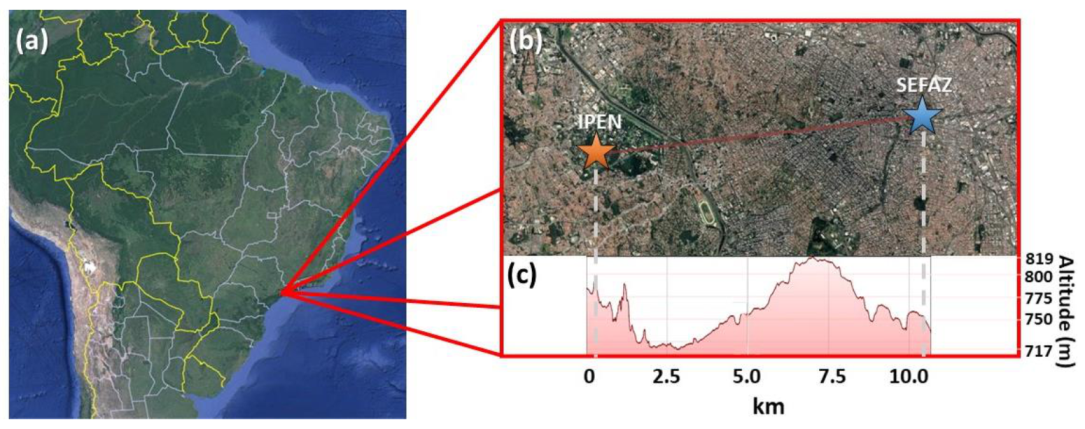
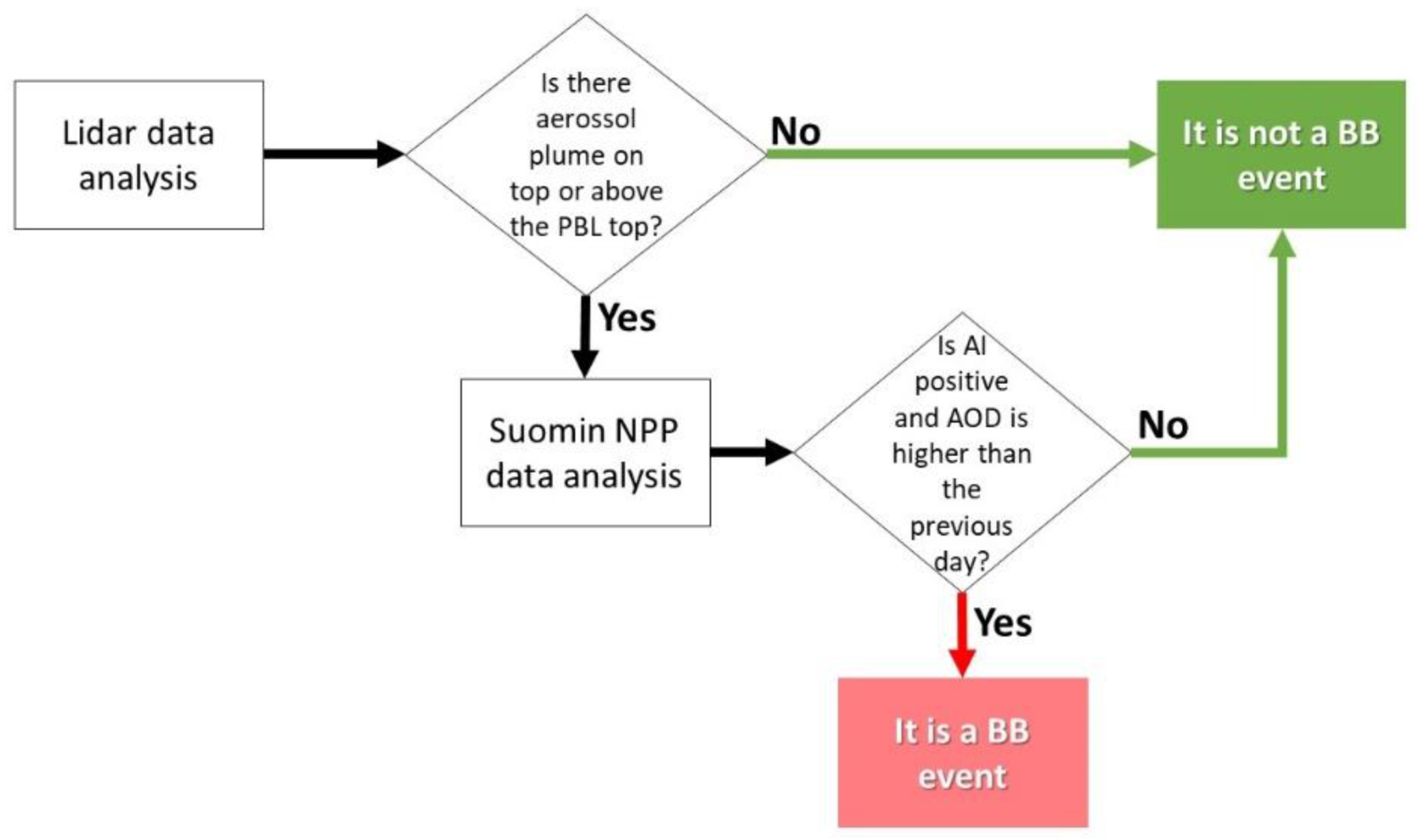


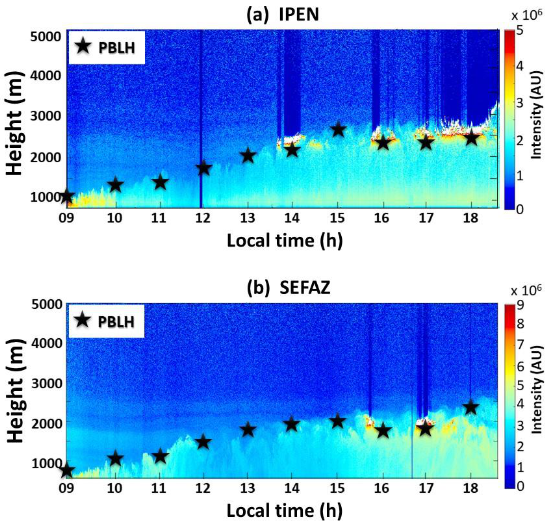


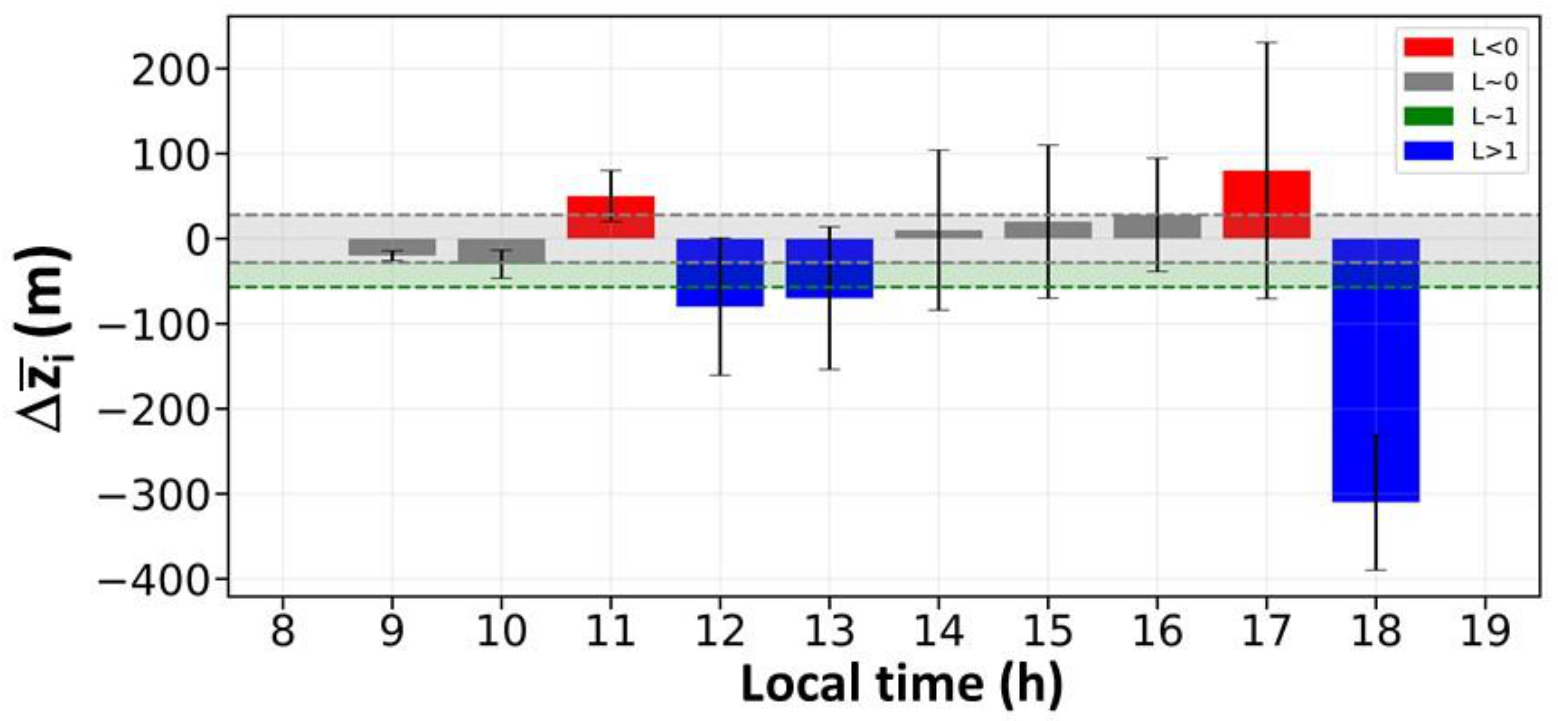


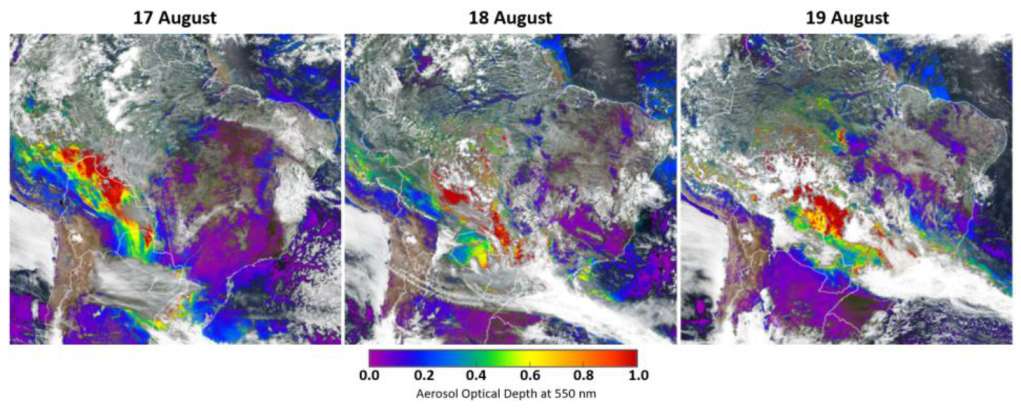
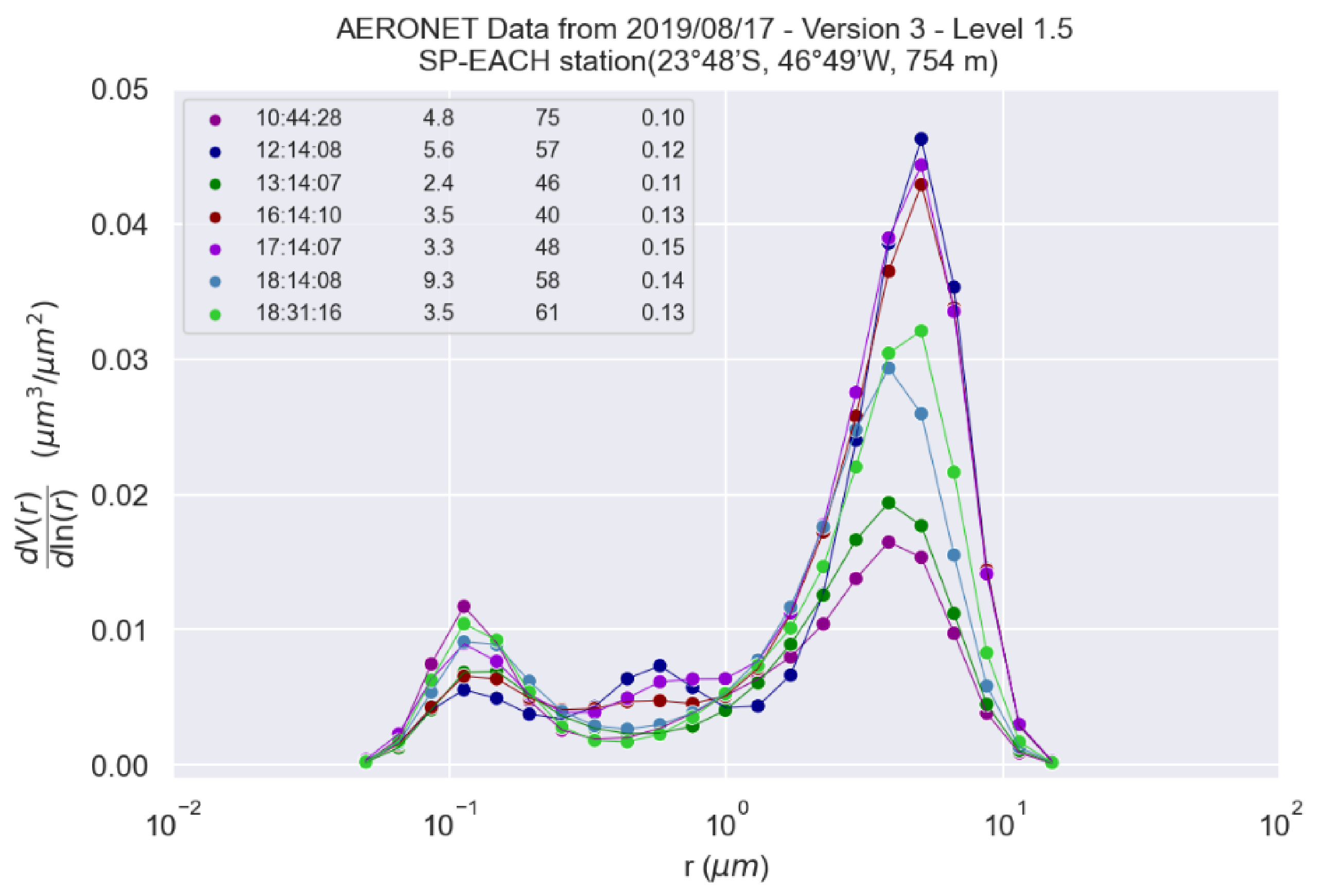
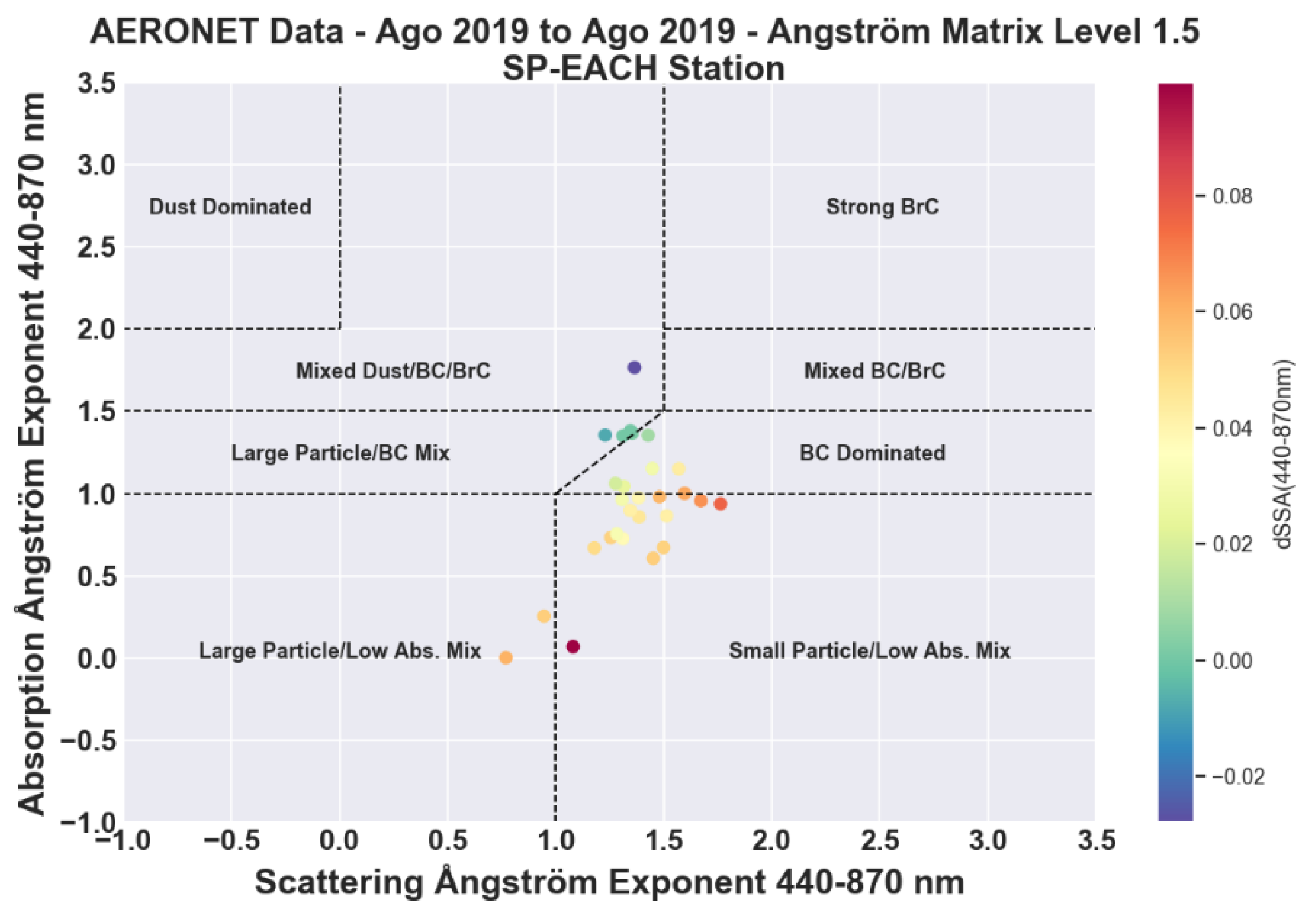
| L | Δzi = PBLHSEFAZ − PBLHIPEN | Behavior of PBLH with Respect to Topography |
|---|---|---|
| L < 0 | Δzi > 29 m | PBLH varies opposite to topography |
| L~0 | |Δzi| < 29 m | PBLH tends to level |
| L~1 | −57 m ≥ Δzi ≥ −29 m | PBLH tends to follow the topography |
| L > 1 | Δzi < −57 m | PBLH differences are larger than topographic ones |
Publisher’s Note: MDPI stays neutral with regard to jurisdictional claims in published maps and institutional affiliations. |
© 2022 by the authors. Licensee MDPI, Basel, Switzerland. This article is an open access article distributed under the terms and conditions of the Creative Commons Attribution (CC BY) license (https://creativecommons.org/licenses/by/4.0/).
Share and Cite
Moreira, G.d.A.; Oliveira, A.P.d.; Codato, G.; Sánchez, M.P.; Tito, J.V.; Silva, L.A.H.e.; Silveira, L.C.d.; Silva, J.J.d.; Lopes, F.J.d.S.; Landulfo, E. Assessing Spatial Variation of PBL Height and Aerosol Layer Aloft in São Paulo Megacity Using Simultaneously Two Lidar during Winter 2019. Atmosphere 2022, 13, 611. https://doi.org/10.3390/atmos13040611
Moreira GdA, Oliveira APd, Codato G, Sánchez MP, Tito JV, Silva LAHe, Silveira LCd, Silva JJd, Lopes FJdS, Landulfo E. Assessing Spatial Variation of PBL Height and Aerosol Layer Aloft in São Paulo Megacity Using Simultaneously Two Lidar during Winter 2019. Atmosphere. 2022; 13(4):611. https://doi.org/10.3390/atmos13040611
Chicago/Turabian StyleMoreira, Gregori de Arruda, Amauri Pereira de Oliveira, Georgia Codato, Maciel Piñero Sánchez, Janet Valdés Tito, Leonardo Alberto Hussni e Silva, Lucas Cardoso da Silveira, Jonatan João da Silva, Fábio Juliano da Silva Lopes, and Eduardo Landulfo. 2022. "Assessing Spatial Variation of PBL Height and Aerosol Layer Aloft in São Paulo Megacity Using Simultaneously Two Lidar during Winter 2019" Atmosphere 13, no. 4: 611. https://doi.org/10.3390/atmos13040611







